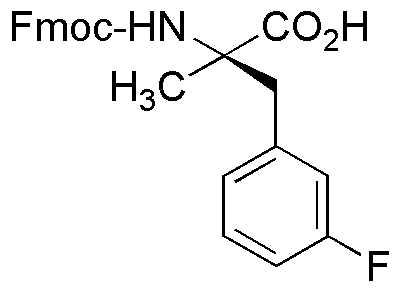Fmoc-a-methyl-D-3-fluorophenylalanine is widely utilized in research focused on:
- Peptide Synthesis: This compound serves as a key building block in the synthesis of peptides, allowing researchers to create custom sequences for various applications in drug development and biological studies.
- Drug Discovery: Its unique fluorinated structure enhances the pharmacokinetic properties of peptides, making it valuable in the design of novel therapeutics that require improved stability and bioavailability.
- Bioconjugation: The chemical can be used in bioconjugation techniques, facilitating the attachment of peptides to other molecules, such as antibodies or nanoparticles, for targeted drug delivery systems.
- Research in Neuroscience: Due to its ability to mimic natural amino acids, it is employed in studies related to neurotransmitter function and receptor interactions, contributing to advancements in understanding neurological disorders.
- Protein Engineering: This compound aids in the modification of proteins, allowing scientists to enhance their properties or create novel functionalities, which is essential for various applications in biotechnology and pharmaceuticals.
General Information
Properties
Safety and Regulations
Applications
Fmoc-a-methyl-D-3-fluorophenylalanine is widely utilized in research focused on:
- Peptide Synthesis: This compound serves as a key building block in the synthesis of peptides, allowing researchers to create custom sequences for various applications in drug development and biological studies.
- Drug Discovery: Its unique fluorinated structure enhances the pharmacokinetic properties of peptides, making it valuable in the design of novel therapeutics that require improved stability and bioavailability.
- Bioconjugation: The chemical can be used in bioconjugation techniques, facilitating the attachment of peptides to other molecules, such as antibodies or nanoparticles, for targeted drug delivery systems.
- Research in Neuroscience: Due to its ability to mimic natural amino acids, it is employed in studies related to neurotransmitter function and receptor interactions, contributing to advancements in understanding neurological disorders.
- Protein Engineering: This compound aids in the modification of proteins, allowing scientists to enhance their properties or create novel functionalities, which is essential for various applications in biotechnology and pharmaceuticals.
Documents
Safety Data Sheets (SDS)
The SDS provides comprehensive safety information on handling, storage, and disposal of the product.
Product Specification (PS)
The PS provides a comprehensive breakdown of the product’s properties, including chemical composition, physical state, purity, and storage requirements. It also details acceptable quality ranges and the product's intended applications.
Certificates of Analysis (COA)
Search for Certificates of Analysis (COA) by entering the products Lot Number. Lot and Batch Numbers can be found on a product’s label following the words ‘Lot’ or ‘Batch’.
Numéro de catalogue
Numéro de lot/série
Certificates Of Origin (COO)
This COO confirms the country where the product was manufactured, and also details the materials and components used in it and whether it is derived from natural, synthetic, or other specific sources. This certificate may be required for customs, trade, and regulatory compliance.
Numéro de catalogue
Numéro de lot/série
Safety Data Sheets (SDS)
The SDS provides comprehensive safety information on handling, storage, and disposal of the product.
DownloadProduct Specification (PS)
The PS provides a comprehensive breakdown of the product’s properties, including chemical composition, physical state, purity, and storage requirements. It also details acceptable quality ranges and the product's intended applications.
DownloadCertificates of Analysis (COA)
Search for Certificates of Analysis (COA) by entering the products Lot Number. Lot and Batch Numbers can be found on a product’s label following the words ‘Lot’ or ‘Batch’.
Numéro de catalogue
Numéro de lot/série
Certificates Of Origin (COO)
This COO confirms the country where the product was manufactured, and also details the materials and components used in it and whether it is derived from natural, synthetic, or other specific sources. This certificate may be required for customs, trade, and regulatory compliance.


